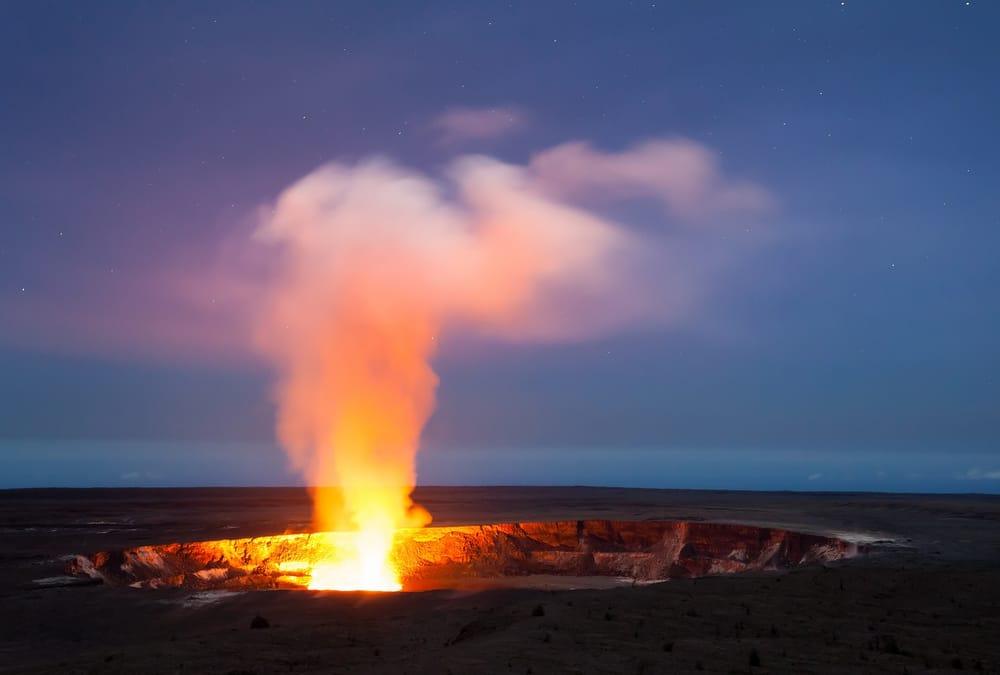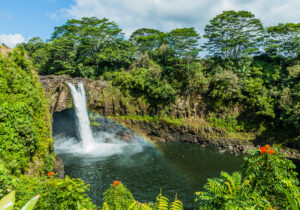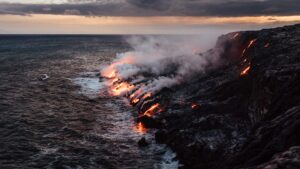Hawaiʻi Guide as of June 1st on where the lava is flowing. Join us on one of our volcano tours to visit this incredible force of nature in comfort and luxury.
Where is the lava flowing in Volcanoes National Park?
Where is the Lava?
Hawaiʻi Eruption Updates for 2022
If you’re heading to Hawaiʻi’s Big Island, then one of the first questions you may have is, ‘Where is the lava? I want to see lava! Wait, or is it magma?’ First, yes, typically it’s lava you’re looking for – lava is anything that’s erupted from the volcano (to the surface), and it comes in two flavors, Pahoehoe and A`a. You can read more about the two lava types on our Hawaiʻi Geology page. If it’s still within the volcano, it’s known as magma.
September 2021 – June 2022 Eruption Update
Lava has Returned to Halemaumau Crater in HVNP!
For the first time since May 2021, ACTIVE flows are now occurring inside Halemaumau Crater at Hawaiʻi Volcanoes National Park. See our ‘What’s Happening Now‘ section below for current information.
Locating the Lava Flows
Now, to answer the question of ‘where.’ Well, the answer to that question depends on the mood of Pele (the Hawaiʻian Volcano Goddess). And Madame Pele is very unpredictable.
Hawaiʻi Volcanoes National Park is open 24 hours a day, so your chance to see glowing lava (from near or far) is pretty good when the volcano is actively erupting (it’s periodically erupting only at the summit in Halemaumau currently), especially when it’s dark. Just look for the red glow. As always, the Park Rangers at the entry station are your best guide to current conditions – we advise all visitors to check in with them before exploring the park.
Ultimately, in our opinion, even if you don’t get to see any flowing lava in person, which you might not currently, Hawaiʻi Volcanoes National Park and the Big Island are well worth the time.
What’s Happening Now?
September 2021 – June 2022 Eruption
Kilauea volcano, on the Big Island of Hawaiʻi, is currently erupting at its summit – flooding the floor of Halemaumau Crater with fresh lava flows. Current conditions are additionally included below.
Eruption Timeline
The latest eruption within Halemaumau Crater started about 20 minutes after 3 p.m. Wednesday – September 29, 2021; currently, all lava is confined within the crater. The eruption came after a day of increased earthquake activity at the volcano and summit.
The eruption is currently confined to Halemaumau crater, within Hawaiʻi Volcanoes National Park. HVO does not see any indication of activity migrating elsewhere on Kilauea volcano and expects the eruption to remain confined to the summit region.
The last eruption at Kilauea ended in May (see below) after an explosive beginning five months earlier in December 2020. It is unclear how long the current eruption will continue. Kilauea summit eruptions over the past 200 years have lasted from less than a day to more than a decade. This ongoing eruption is similar to the most recent Kilauea eruption, which was also confined to Halemaʻumaʻu crater and generated a lava lake; the most recent eruption lasted approximately five months, from December 2020 to May 2021.
Current Conditions Summary*
If you’re currently on the Big Island, this is a great time to witness the glow of an eruption up close on the summit; as usual, nighttime viewing is best. Dress accordingly as it’s 4,000+ ft in elevation at the summit of Kilauea and it can get fairly chilly after dark. Below we’ve also covered What you can see during both the daytime and at night.
Activity Summary: Current conditions, updated daily, can be found on the USGS site.
*Activity Summary, Summit Observations, and Lava Lake Observations courtesy of the USGS and/or NPS
What can you see in the day?
- Visitors arriving at HVNP during the day can view the volcanic gas and steam from the eruption within Halemaʻumaʻu crater. Koaʻekea (white-tailed tropicbirds) are often observed flying above the crater.
- The eruption is visible from Kaluapele, the summit caldera, along open areas of the rim. Lava fountains are only visible from the south caldera rim near Keanakākoʻi Overlook. Avoid crowds and traffic by visiting this overlook during the day.
- Weather conditions such as fog and rain may obscure eruption views at any time. Be prepared.
What can you see at night?
- he massive lava lake consisting of molten rock casts an incredible reddish-orange glow into the surrounding dark sky. The glow reflects onto the gas plume wafting out of the volcano, and to any clouds above Halemaʻumaʻu crater. The jagged crater walls are additionally illuminated, showcasing the scars dating to the 2018 summit collapse.
- The bursting spatter cone and lava lake is visible from the south rim along Old Crater Rim Drive after a moderate hike. For easier viewing, the lava lake is occasionally visible from Kīlauea Overlook, and along Crater Rim Trail near that area.
- Bring a flashlight during your visit! Weather conditions such as fog and rain may obscure eruption views.
Potential Hazards: This new eruption at Kilauea’s summit is occurring within a closed area of Hawai’i Volcanoes National Park. Therefore, high levels of volcanic gas are the primary hazard of concern, as this hazard can have far-reaching effects downwind. Large amounts of volcanic gas—primarily water vapor (H2O), carbon dioxide (CO2), and sulfur dioxide (SO2)—are continuously released during the eruptions of Kilauea Volcano. As SO2 is released from the summit, it reacts in the atmosphere to create the visible haze known as vog (volcanic smog) that has been observed downwind of Kīlauea. Click here to also view the latest Vog report for the Big Island of Hawaiʻi.
Follow HVNP for additional updates
This situation is rapidly evolving and the Hawaiʻi Volcanoes Observatory will continue to issue statements when more information is available to the public. For now, you can receive ongoing eruption updates by following the social media accounts of the Hawaiʻi Volcanoes National Park (Facebook, Instagram, and Twitter).
- View the live cameras located at the Kilauea summit.
- Additional updates can be found on the Hawaiʻi Volcanoes National park website.
- Animated GIF of the latest webcam footage from the current eruption
Lava returns to Halemaumau Crater
September 2021 – June 2022 Eruption
As noted above, this eruption began on September 29, 2021. We will continue to post updates on this page, as the eruption continues. This section will be updated accordingly.
December 2020 – May 2021 Eruption
After the huge changes that occurred with the 2018 eruption and subsequent summit collapse, some had speculated that Kilauea would not erupt for a significant period of time. Pele had other plans, however.
At approximately 9:30 p.m. HST on Sunday – December 20, 2020, the USGS Hawaiʻian Volcano Observatory (HVO) detected a new glow within the Halemaumau crater at the summit of Kilauea Volcano.
Within Halemaumau, an eruption had commenced at Kilauea’s summit caldera. Previously, as noted below the caldera had been filling with a green-ish water lake, but that quickly disappeared, as lava has once again made an appearance inside of the crater. Within one week, what had been a history-making lake of water was replaced by a nearly 600-foot deep lake of molten lava.
A magnitude 4.4 earthquake additionally hit about an hour after the volcano began erupting. By the morning of 12/21/20, two of the three initial fissure vents on the wall of the Halemaumau crater were feeding a growing lava lake.
The eruption paused in late May 2021, after several months of activity in the Halemaumau crater.
Development of Water Lake in 2019
On August 1, 2019, USGS Hawaiʻian Volcano Observatory (HVO) scientists confirmed a growing pond of water in the recently enlarged Halemumau crater. Initially, it appeared as small, separate turquoise ponds, but over time, the small ponds united and began to grow dramatically. For a period of time, the depth of the growing lake was increasing several inches per day.
In the space of just over one year’s time, a persistent lake of lava had vanished in a dramatic collapse, only to be replaced by the first lake of water to be recorded at Kilauea in modern history.
Over the course of its relatively short lifespan, the lake grew to be approximately 160 feet (49 m) deep. That’s taller than a 10-story building, for reference. The lake also changed color due to the precipitation of iron-sulfate minerals and SO2 being dissolved into the water.
2018 East Rift Zone Eruption
Kilauea caldera has undergone a tremendous amount of change over the last decade, and prior to the eruption in December 2020, had not been very active since 2018. See the maps immediately below to get an idea of how volatile the years between 2009 and 2018 were at the park or explore this geo-narrative by the USGS about the 2018 eruption.
In the first days of May 2018, the lava lake that had existed in Halemaumau crater for almost a decade began to drain away. Magma moved from the summit of Kilauea to the Lower East Rift Zone, marked by a series of earthquakes. On May 3rd, the first fissures opened up in the subdivision of Leilani Estates and the massive eruption of 2018 began to unfold in lower Puna.
With less magma left to support the summit, the Halemaumau crater began to collapse. Every 28 hours, on average, the ground within the summit caldera of Kilauea sank with dramatic collapse events. By the end of the 2018 eruption, the Halemaumau crater had sunk by 1,600 feet (488m), and its diameter more than doubled.
Activity circa 2018 East Rift Zone Eruption
Prior to 2018, you could just as easily have witnessed lava flows chewing on Chain of Craters Road as you could view a steam plume from afar. Kilauea is a living, breathing volcano with a mind of its own.
Kilauea’s oldest lava flows are dated between 210,000 and 280,000 years ago. Those flows are considered generally young, geologically speaking, for an active volcano.
For the last one thousand years, Kilauea’s ongoing eruptions have dramatically shaped the southeast portion of the Big Island of Hawaiʻi.
The most recent 100 years of volcanic activity at Kilauea can be divided into seven distinct eruptions.
Summaries are provided below from the USGS website:
- May 1924 explosive eruption
- 1955 Lower East Rift Zone Eruption
- 1959 eruption of the Kilauea Iki
- 1960 Kapoho eruption
- 1969-1974 Mauna Ulu Eruption
- 2008-2018 Summit Eruption & Lava Lake
- 1983-2018 Pu’u ‘O’o Eruption
Lava Viewing Guide
Hiking to Lava
Check THIS SITE for updates on lava flows and Kilauea activity. We’ve also included some maps below to generally help provide you an overview of the park and where the lava might be located during your visit. Just remember, this is an active living and breathing volcano and things regularly change, the maps are always out of date for that reason to some extent.
If the flows have recently been near the surface within the Park and IF it’s safe to access (check with the Rangers), it’s pretty easy to locate the lava yourself – so don’t feel like you HAVE to join a tour to experience a lava flow. Before heading out, be sure you’ve prepared accordingly – dress appropriately with the right footwear for your adventure; be sure to keep water with you at all times, it can be easy to get dehydrated on the lava fields. Sunscreen is also your best friend on this part of the island.
As always, remember that lava flows outside the Park’s boundary are on private property and you should not explore these locations without a guide who has permission to properly access the property.





